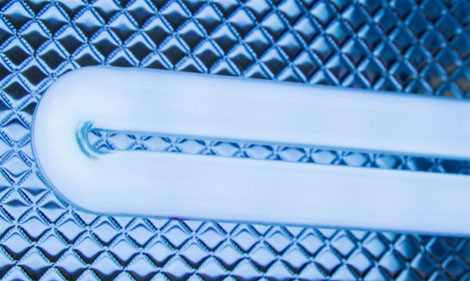

UV Disinfection In Wastewater Treatment

An ultraviolet (UV) disinfection system is an effective way to remove microbial contamination in wastewater. The UV disinfection system is part of the tertiary treatment of wastewater and normally follows a filtration process. In the system, microbes are exposed to UV light that destroys their DNA. Destroying these microbes disinfects the water. UV disinfection systems are used in many different applications ranging from the purification of drinking water to wastewater treatment. We will be focusing specifically on wastewater treatment. UV disinfection is a safe and cost-effective wastewater treatment application.
UV Disinfection and Microorganisms
In UV wastewater disinfection technology, ultraviolet light is used for the disinfection of bacteria, viruses, molds, algae, and other microorganisms. UV light disinfects by penetrating microorganisms and destroying their DNA. DNA plays an important role in organisms’ functions and reproduction; destroying the DNA prevents the organism from growing and multiplying. In wastewater treatment, one microorganism that is of specific importance is fecal coliform. Fecal coliforms are used as indicator organisms for fecal contamination. If fecal coliform is present in a wastewater treatment plant effluent, then it can be assumed that other harmful forms of microorganisms are, too. A high level of fecal coliform can also mean that the UV disinfection system is not functioning properly.
Parts of a UV System
An ultraviolet disinfection system is not simply a lamp inside a channel. The four basic parts of a UV system include the lamp, quartz sleeve, reactor, and ballast. The ballast controls the UV bulbs which are housed in a quartz sleeve. The area that contains the bulbs is the reactor. There are two types of reactors: contact and noncontact. Wastewater can flow perpendicular or parallel to lamps in both reactors. However, contact reactors have lamps in quartz sleeves submerged in wastewater, while in noncontact reactors, the lamps are suspended above a clear conduit that wastewater flows into.
Contact UV disinfection systems are more common. UV reactors must be designed to ensure that all microbes receive sufficient exposure to the UV light. Based on the hydraulic properties of water, the reactor needs to be optimized to guide the flow in a manner to maximize contact time and turbulence. Along with hydraulic properties, UV transmittance (UVT) is a measurement used to determine how much UV light passes through a sample of water compared to distilled water. Dissolved organics, suspended particulates, color, and certain UV light absorbing metals are the main absorbers of UV light. UVT is the key factor in properly sizing a UV system to operate effectively.
UV Disinfection, Chlorination, and Ozonation
UV disinfection is often preferred over other systems such as chlorination or ozonation. UV disinfection has low capital and operating costs. The installation and maintenance of the system is also easier. The contact time required for disinfection is much less than chlorination or ozonation. The UV system is also generally safer without having to use and store dangerous toxic corrosive substances such as chlorine gas or ozone. Some disadvantages to a UV system are that preventive maintenance programs must be used to keep the lamps clean. High turbidity and total suspended solids (TSS) can render the disinfection ineffective, and some organisms can repair and reverse the UV damage.